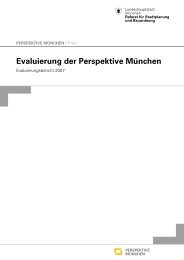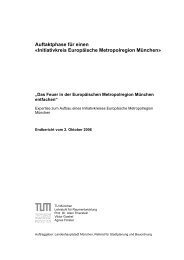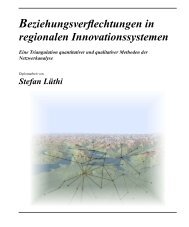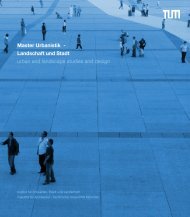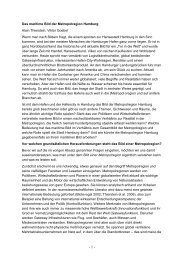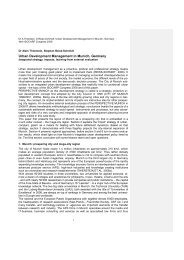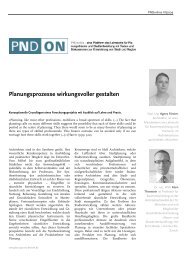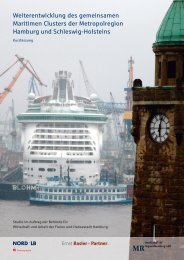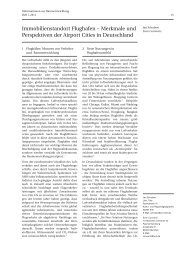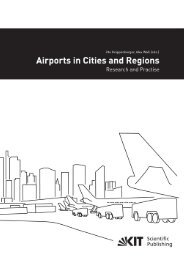0.6-1-Cover and Table of Contents-pp 0-05.indd - Raumentwicklung ...
0.6-1-Cover and Table of Contents-pp 0-05.indd - Raumentwicklung ...
0.6-1-Cover and Table of Contents-pp 0-05.indd - Raumentwicklung ...
You also want an ePaper? Increase the reach of your titles
YUMPU automatically turns print PDFs into web optimized ePapers that Google loves.
The Role <strong>of</strong> the Design Studio in Shaping an Architectural Education for Sustainable Development:<br />
The Case <strong>of</strong> Beirut Arab University<br />
KHALID S. AL-HAGLA<br />
guidance regarding social <strong>and</strong> economic<br />
dimensions “The design studio makes emphasis<br />
on environmental sustainability <strong>and</strong> forgets<br />
all about the social <strong>and</strong> economic aspects.<br />
More guidance in studio according to social,<br />
economical, <strong>and</strong> environmental sustainability<br />
must be taken in consideration”. The previously<br />
studied courses (m<strong>and</strong>atory <strong>and</strong> electives) do<br />
not help students to build a comprehensive<br />
underst<strong>and</strong>ing <strong>of</strong> the integrated typology<br />
<strong>of</strong> the different sustainability dimensions. The<br />
respondents’ comments come to ensure this<br />
fact “I think we should have more courses<br />
about sustainability not only environmental<br />
one but give some importance for social <strong>and</strong><br />
economic, we should study about the three<br />
parts <strong>of</strong> sustainability equally to produce a<br />
better project. Instead <strong>of</strong> Human Rights, Arabic,<br />
<strong>and</strong> English -university m<strong>and</strong>atory courses,<br />
Sustainability courses (Social, Environmental,<br />
<strong>and</strong> Economical) should be given”. Additionally,<br />
the comments show evaluation as an added<br />
element that should place a greater focus<br />
on the environmental sustainability dimension<br />
<strong>and</strong> the evaluation make more emphasize<br />
on environmental sustainability, than social<br />
sustainability, <strong>and</strong> hardly any emphasize on<br />
economic sustainability aspects.<br />
Design Studio<br />
<strong>Table</strong> 3 shows the questionnaire findings <strong>and</strong><br />
the score <strong>of</strong> each <strong>of</strong> the five mentioned aspects<br />
<strong>and</strong> their subdivisions. The first <strong>of</strong> these aspects<br />
is the place. The results show the positive<br />
impacts <strong>of</strong> the place <strong>of</strong> the study on attaining<br />
sustainability underst<strong>and</strong>ings. The natural<br />
features <strong>of</strong> BAU’s new campus at Debbieh<br />
scored the highest compared with the Faculty<br />
building (the second) <strong>and</strong> the studio layout<br />
(the third). While there is a consensus between<br />
the respondents <strong>of</strong> the three levels on the vital<br />
role that the natural features <strong>of</strong> the site play (as<br />
indicated by the high rating score), there are<br />
differences in their perspectives towards the<br />
layout <strong>of</strong> the studio. This could be seen as the<br />
result <strong>of</strong> different studio layouts <strong>and</strong> the potential<br />
<strong>of</strong> each layout to facilitate communication <strong>and</strong><br />
interaction within the design studio.<br />
In spite <strong>of</strong> being one <strong>of</strong> the most important<br />
aspects, as indicated in respondents’ comments,<br />
in attaining an underst<strong>and</strong>ing <strong>of</strong> sustainability,<br />
the ‘Curriculum’ <strong>and</strong> its related sub-items<br />
show the lowest scores compared with other<br />
items. The detailed results, while showing a<br />
relative a<strong>pp</strong>reciation for the previously studied<br />
Architectural m<strong>and</strong>atory courses, show both the<br />
previously studied m<strong>and</strong>atory engineering courses<br />
<strong>and</strong> the university’s elective courses as having very<br />
minor impacts. This reflects a major deficiency<br />
in creating transdisciplinary <strong>and</strong> interdisciplinary<br />
channels as m<strong>and</strong>atory features to attaining a<br />
deep underst<strong>and</strong>ing <strong>of</strong> sustainability.<br />
A respondent commented, “…I think there<br />
should be elective & m<strong>and</strong>atory courses<br />
that would guide students towards better<br />
sustainable designs….” However, the fifth level<br />
respondents show higher scores compared<br />
with both fourth <strong>and</strong> third level respondents<br />
when it comes to ensuring the impacts <strong>of</strong> the<br />
greater emphasis made at the fourth level to<br />
the underst<strong>and</strong>ing <strong>of</strong> sustainability. The results<br />
show a gap in the cumulative underst<strong>and</strong>ing<br />
<strong>of</strong> sustainability between different consecutive<br />
levels. Respondents noted that “…the study<br />
in the previous years doesn’t give good<br />
sustainability background…. We need more<br />
organized system, in order to pass from level<br />
to another“. While the results scored in table 3<br />
Archnet-IJAR, International Journal <strong>of</strong> Architectural Research - Volume 6 - Issue 1 - March 2012<br />
35



